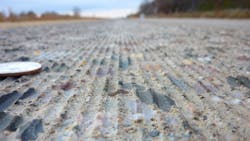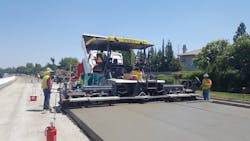Diamonds Make Roller-Compacted Concrete Shine
When the equipment rolls onto the jobsite, it might look like just another asphalt paving project. But look closer: increasingly, the mix coming out of the asphalt paver is concrete—albeit a drier mix than what comes out of a chute.
The finished product is referred to as roller-compacted concrete (RCC). A zero-slump concrete mix, RCC doesn’t need formwork, dowels, or rebar, and it requires minimal finishing. But one element of traditional concrete paving shouldn’t be abandoned—diamond grinding the surface for smoothness. While it was once common to overlay RCC with asphalt, specifiers are now taking advantage of the performance and environmental benefits of a concrete surface. And when incorporating a diamond-ground surface, the completed pavement will be quiet, smooth, and pleasurable to drive on. Diamond grinding is the removal of a thin layer of hardened concrete pavement surface using a self-propelled machine outfitted with a series of closely spaced diamond saw blades mounted on a rotating shaft. Diamond grinding is primarily conducted to restore or improve ride quality, but it also provides improvements in surface texture and reductions in noise levels.
The Finishing Touch
When it was introduced in the 1970s, the rougher surface of RCC caused it to be used mostly on industrial or service roads. Eventually, however, the benefits of RCC led to it being more widely adopted for use on municipal streets, county roads, and parking lots, driving the need for smoother surfaces. RCC can be effectively mixed at high volumes, then delivered to the jobsite where it is quickly and easily placed. Vibratory rollers compact the concrete until it densifies, creating a strong, durable pavement that will resist softening, deforming, or rutting. RCC offers a long service life when compared to similarly priced asphalt pavements. It also requires little maintenance, typically needing only minor patching in isolated areas after decades of traffic loading. The reduction in maintenance also means an overall reduction in lifetime cost.
With so many benefits, RCC installations in the U.S. have increased across many different project types. Between 2014 and 2016, over 1.6 million sq yd (1.3 million sq meters) of RCC were placed each year, according to research performed by Corey J. Zollinger, Chairman of the RCC Pavement Council. Many of these were residential streets owned by private developers, although the method is also being used by municipalities and state DOTs, notably Texas, California, and Virginia.
“When used for roads where the speed of travel exceeds 35 miles per hour, RCC surfaces as installed may not be smooth enough,” said Zollinger. “Diamond grinding smooths the pavement surface, making it suitable for higher speed travel.”
In addition to improvements in RCC surface texture through diamond grinding, recent years have seen improvements to mix design, mix production and placing, as reported in Zollinger’s paper “Recent Advances and Uses of Roller Compacted Concrete for Pavement Construction in the United States.” In metropolitan areas with mature markets, the demand for RCC has allowed concrete suppliers to supply RCC from fixed locations, as opposed to mobilizing plants and paving equipment to the project site, making smaller projects feasible.
Choosing RCC
The city of Roseville, Calif., selected three diverse roadways for a 2018 RCC pilot project that, to date, has received six industry awards. Washington Boulevard is a five-lane arterial, Atkinson Street is a two-lane collector road, and Hickory Street is a low-volume residential street. More than two miles of failed sections of existing asphalt pavement distributed across the three roadways were reconstructed using RCC, helping this project achieve several “firsts” in California.
The roadways were originally constructed in the early to mid-1900s and as Roseville grew and developed, piecemeal paving work resulted in varying levels of pavement quality. Potholes and roughness were ongoing problems in several locations and resident complaints were requiring the city to make too-frequent repairs. Eventually, the number of lane miles needing repair far outstripped the funding available and a backlog was developing.
At that point, the city wanted to switch to a more durable concrete pavement. Any concrete solution considered, however, had to be cost-competitive.
“We extensively researched roller-compacted concrete,” said Noah Siviglia, Associate Engineer with the Department of Public Works—Engineering, City of Roseville. “The initial cost of installing the concrete was similar to that of asphalt—it was about 10% lower—and there were maintenance benefits to choosing concrete, when considered over the life of the road.”
Written into the specs was a 30-minute cap on the time from concrete mixing to compaction, so a mobile pug mill was set up close to the construction site. While a mobile plant is a significant project cost, the approximately two miles of paving installed in Roseville justified the cost.
After the concrete was delivered, placed and compacted with a high-density paving machine, early entry saw cuts were made to create joints while the pavement was still green (although because the concrete used for RCC is a dry mix, minimal pavement shrinkage occurs). Dowel bars were not used in the design; pavement designers relied upon aggregate interlock for load transfer instead. Roseville’s finished RCC surface was then diamond ground across the entire surface to correct ride deficiencies, increase friction, and reduce tire/pavement noise, leaving the standard, corduroy-like surface texture.
To stay on schedule, rapid construction was a priority. Before construction began, the team developed a concrete mix design that was able to reach the city’s specification of at least 2,500 psi unconfined compressive strength within two days. This allowed the roads to be fully opened to traffic quickly; for cross-traffic, intersections were opened by the end of each work shift.
“RCC is a good option when working in a developed area,” said Siviglia. “There are no long road closures while the concrete cures—it’s a very hard surface almost from the moment it comes out of the machine. As compared to traditional portland cement concrete pavement, the lane or road closure duration can be far reduced.”
After the project was complete, in fall 2018, the city received positive feedback from local drivers due to the minimal project disruption and smooth ride.
“RCC gives cities another option for their paving projects—and having options always helps keep costs competitive,” pointed out Siviglia.
“It is interesting to note that diamond grinding was first used in California in 1965 on a then-19-year-old section of I-10 to eliminate significant joint faulting and ride quality issues. This was followed by subsequent grinding events in 1983, 1997, and 2017, helping to preserve a nearly 75-year-old concrete pavement that still serves the traveling public today. I believe that the durability of RCC, paired with a diamond ground surface finish, gives these pavements the DNA to exceed that longevity milestone,” said John Roberts, Executive Director, International Grooving & Grinding Association.
Award-Winning Project
Roseville’s roller-compacted concrete (RCC) pilot project has been the recipient of six awards:
-
California Transportation Foundation
CTF Transportation Award: Local Street Project of the Year
Won: March 2019 -
The League of California Cities® and County Engineers Association of California (CEAC)
2019 Outstanding Local Streets and Roads Project Awards: Efficient and Sustainable Road Maintenance, Construction and Reconstruction Projects
Won: April 2019 -
American Society of Civil Engineers, Sacramento Section
Outstanding 2018 Project Awards: Outstanding Sustainable Engineering Project
Won: April 2019 -
American Public Works Association (APWA), Sacramento Chapter
2019 Project of the Year, Transportation
Won: May 2019 -
American Council of Engineering Companies (ACEC), Sierra Chapter
Engineering Excellence Award: Best Transportation Project
Won: October 2019 -
American Concrete Pavement Association (ACPA)
30th annual “Excellence in Concrete Pavements” Awards: Gold Award
Won: December 2019


